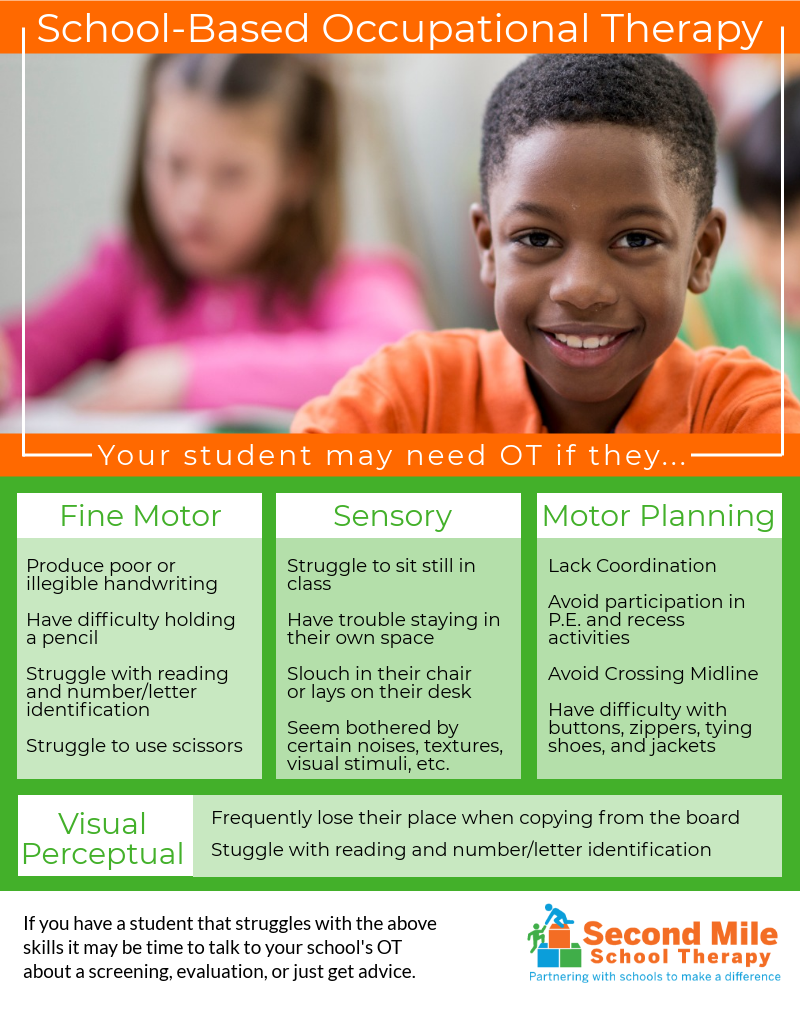Interacting with students every day, teachers are sometimes the first to notice a child’s developmental issues. On a routine basis, they witness how children navigate day-to-day tasks and interact with their peers.
A child may have delayed development or learning difficulties due to factors such as birth defects, traumatic injuries, autism, or other mental or physical disorders. Behaviors like not listening or causing disruptions in the classroom may first appear to be disciplinary. But they might in fact point to an underlying learning, language, sensory, or attention issue.
Teachers can play an important part in the process by recognizing specific behaviors, recommending assessments, and advocating for their students. In-school Occupational Therapy may be a beneficial tool for students who are struggling to reach their developmental goals.
This infographic is a great resource for teachers to save or print out, so they can know what to watch for in students:
Who Can Occupational Therapy Help?
Occupational Therapy – School Based
OT can help your student who…
- Struggles to sit still in class or pay attention
- Has trouble staying in their own space (carpet time, in lines, etc.)
- Slouches in chair or lays on desk
- Produces illegible handwriting
- Has difficulty holding a writing utensil
- Struggles to use scissors
- Frequently loses place when copying from the board
- Has difficulty with daily skills in self-care tasks (buttons, zippers, tying shoes, putting on jacket, etc.)
- Struggles with reading and number/letter identification
- Avoids participation in P.E. and recess activities
- Lacks coordination
- Avoids crossing midline
- Overly rough when interacting with others.
What Kinds of Behaviors Might Indicate a Need for Occupational Therapy?
Occupational Therapy can help children who display developmental delays in a variety of ways and for a variety of reasons. Children may lack coordination, focus, or organizational skills. They often struggle with activities that are common to everyday living. Occupational Therapists can help a child learn to do those activities using exercises targeted to the child’s specific needs.
Teachers have the advantage of seeing a child interact in the classroom. They should be on the lookout for children who are struggling with these issues. Adding in-school Occupational Therapy to a child’s curriculum can improve the child’s ability to learn, which will, in turn, benefit the entire classroom.
Occupational Therapy for Attention and Focus Issues
Problems focusing in class and paying attention are common for many children from time to time. But if a child has a hard time focusing on a regular basis, there may be an issue. He or she may also have trouble sitting still or staying in their own space. Poor posture, leaning or laying on their desk, or slouching may be signs of an attention issue.
An assessment by an Occupational Therapist can reveal if these behaviors are perhaps a sign of a sensory processing issues or being on the autism spectrum. The OT will be able to work with the child on tools to help.
Occupational Therapy and Coordination Issues
A student who lacks coordination may be a candidate for Occupational Therapy as well. Lagging behind with fine or gross motor skills may present in a number of ways.
A child lacking fine motor skills may have difficulty holding a pencil or using scissors. Their penmanship may not improve with practice. They may struggle with buttons, zippers, and shoelaces.
All young children have some degree of difficulty when first learning these skills. It is important to watch for signs that a student’s struggles go beyond the normal awkwardness of small fingers taking on new tasks.
Gross motor skills involve movement of the larger muscles. Full-body movements like walking, running, or jumping can be difficult. They may avoid crossing the midline of their body when performing tasks. For example, while drawing a horizontal line, they may switch hands when they reach their midline. Or they might have trouble placing an object on one side of their body with the opposite hand.
If a student routinely avoids participating in physical activities at recess or in gym class, an assessment may be in order. Rather than a simple lack of interest in the activity, it could be a coordination problem that would be helped with Occupational Therapy.
Occupational Therapy and Organizational Skills
Children are not known to be the most organized people, but sometimes a lack of planning and organization skills may signal a more serious problem. They may frequently lose their place while completing a task or skip steps necessary to complete an activity. This may present like forgetfulness or absent-mindedness.
These behaviors may seem normal, especially for adolescents. An alert teacher may notice, however, that it is becoming a chronic issue or becoming more severe. When this results in academic problems, a conversation with the special education director or occupational therapist may be in order.
What Can Teachers Do About Occupational Therapy?
The best way a teacher can help a student with cognitive or developmental issues is to be on the lookout for these behaviors. Bringing the concerns to the attention of the special education director, the assessment team, or the occupational therapist is a good first step.
If a student is working with an OT, keeping the line of communication open with them is essential. It will help you both gauge the student’s progress. And finally, keep in touch with your school’s Special Education Director. They are usually on the front line of coordinating in-school Occupational Therapy and will have additional resources to help you help your students.




